Surfboard Fin Setups Guide: Types and Placements
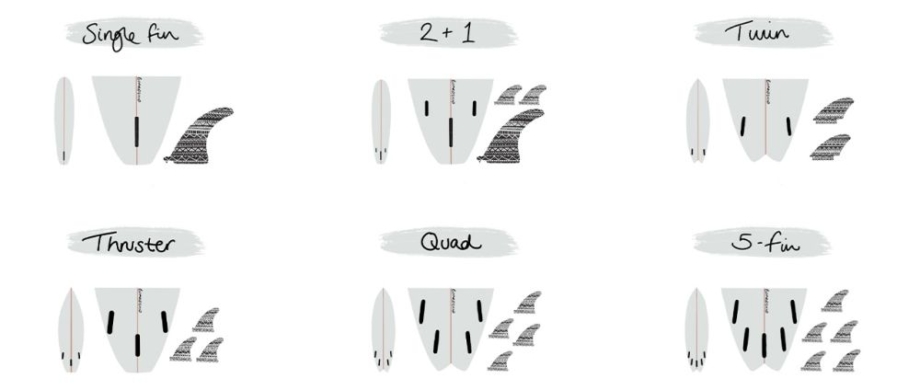
What do fins do on a surfboard? Selecting the proper surfboard fin setup is fundamental to getting your board the most performance and enjoyment. The number of fins, their size, shape, and placement influence how well a surfboard rides. Understanding the types of surfboard fins can unlock new fun levels regardless of your levels. Discover the various surfboard fin setups commonly used, including single fin, twin fin, thruster, 2+1 fin, and quad setups.
This surfboard fins explained guide includes the key differences between surfboard with fins, empowering you to customize your board for the waves you want to ride.
1. Single Fin Setup
The world of surfboard fin setups boasts various configurations, each catering to specific surfing styles and wave conditions. However, the single fin setup is a timeless classic, offering a unique experience for both beginner and seasoned surfers. This minimalist approach, featuring a single fin positioned at the tail of the board, has captivated surfers for decades, offering a distinct blend of performance and character.
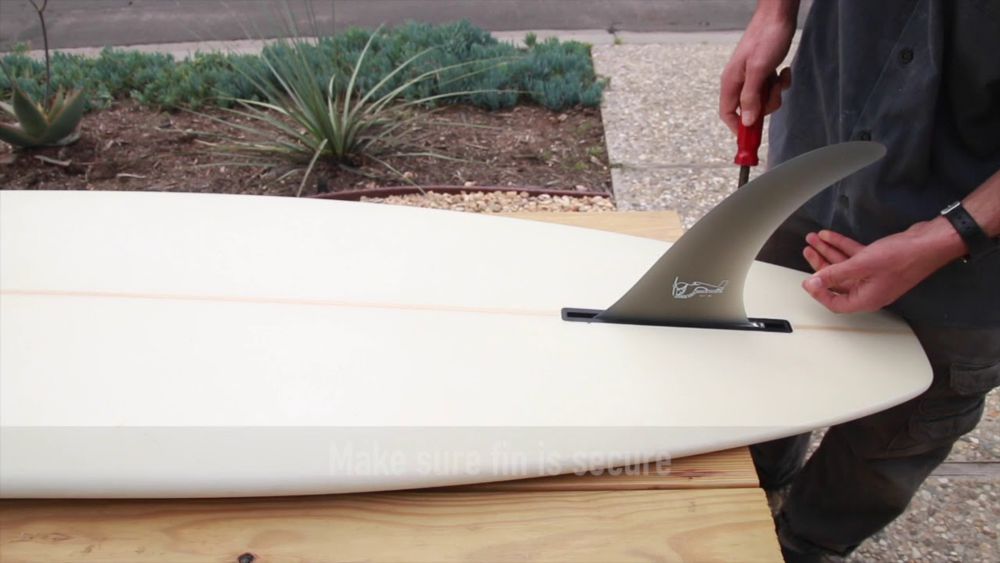
Here’s a closer look at the ideal wave conditions, pros, and cons of single fin setups:
Ideal Conditions:
- Longboard & Mid-Length Surfboards: Single fins are commonly found on longboards and mid-length surfboards, where their large surface area and relaxed rocker profiles complement the boards’ gliding nature.
- Cruising & Noseriding: The single fin setup excels in cruising and noseriding, allowing smooth, drawn-out lines and graceful maneuvers on the wave face.
- Small-to-medium waves: Smaller waves lack the power to push multi-fin setups, making single fins an efficient option for catching and riding them.
Pros:
- Stability: The single fin configuration provides exceptional stability, making it easier to balance and control the board, especially for beginners.
- Glide: With less drag than multi-fin setups, single fins offer superior glide and ease of paddling, allowing surfers to catch waves effortlessly.
- Flow: The single fin encourages smooth, drawn-out turns, fostering a more connected and flowing surfing experience.
- Classic aesthetic: The single fin setup embodies the classic longboard aesthetic and evokes a sense of surfing’s rich history.
- Simple and low maintenance: Single fin setups are easier to maintain and less prone to damage with only one fin.
Cons:
- Maneuverability: Single fins offer less maneuverability than multi-fin setups, making sharp turns and tight maneuvers more challenging.
- Limited performance: In powerful or hollow waves, the single fin may need help to provide the necessary hold and control for high-performance surfing.
- Learning curve: Mastering the single fin requires a different approach compared to multi-fin setups, demanding more balance and body positioning from the surfer.
2. Twin Fins/Dual Fin Setups
Surfboard fin setups are crucial in how a board performs in the water. As the name suggests, Twin fins utilize only two fins, typically positioned symmetrically on either side of the surfboard fin placement box near the tail. This configuration, popularized in the 70s and 80s, has seen a resurgence in recent years, attracting surfers seeking a specific feel and performance characteristics.
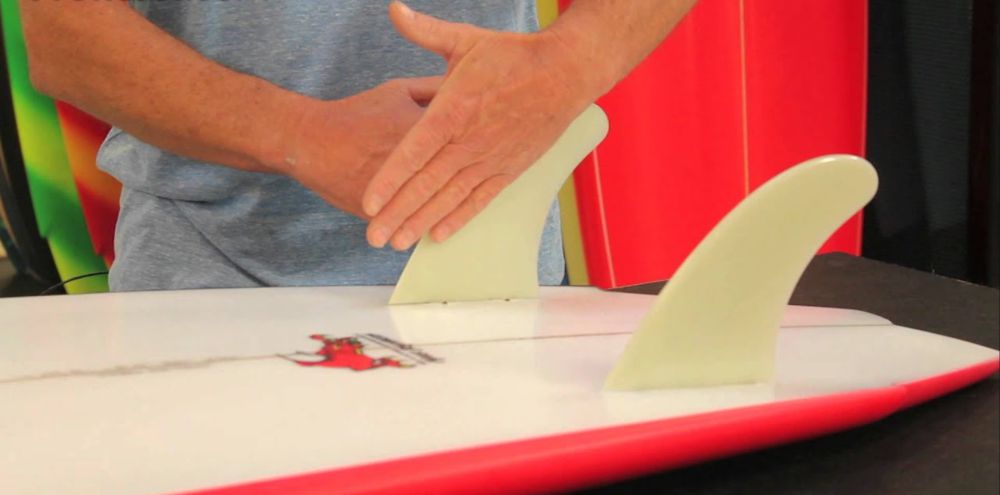
Below is an overview of the ideal wave conditions, pros, and cons of this surfboard fin setup:
Ideal Wave Conditions:
- Small to medium waves: Twin fins excel in waves that lack power and punch. Their loose and maneuverable nature allows surfers to generate their speed and flow through weaker wave sections.
- Clean or choppy conditions: The twin fin setup can handle both glassy and choppy conditions due to its ability to maintain control and looseness in various water states.
Pros:
- Increased maneuverability: With only two fins, twin fins provide a more responsive feel than setups with three or more fins. This allows for quicker and tighter turns, making them ideal for smooth, drawn-out maneuvers.
- Enhanced speed: The reduced drag from fewer fins makes the board accelerate and maintain speed more efficiently, particularly in smaller waves.
- Flowy and smooth ride: Twin fins offer a more skate-like feel than other setups. This looser feel allows for a more relaxed and playful surfing style, focusing on flow and generating speed through turns.
Cons:
- Limited hold in larger waves: Due to lacking a center fin, twin fins need help holding their line in powerful or steeper waves. This can lead to loss of control and difficulty performing tight maneuvers in these conditions.
- Less stability: Compared to setups with three or more fins, twin fins offer less overall stability, especially at higher speeds or when performing aggressive maneuvers.
- Not ideal for beginners: The looser feel and reduced control of twin fins can be challenging for beginner surfers, making them more suitable for experienced surfers comfortable with balance and control.
3. Thruster Fin Setup
The fin placement surfboard significantly impacts its performance and handling characteristics. Developed by Simon Anderson in the 1980s, the thruster fin setup utilizes three fins: two smaller fins on either side of the tail (side fins) and a single, slightly larger fin in the center of the board (center fin). This arrangement offers a balanced combination of stability, control, and maneuverability, making it suitable for various surfers and wave types.
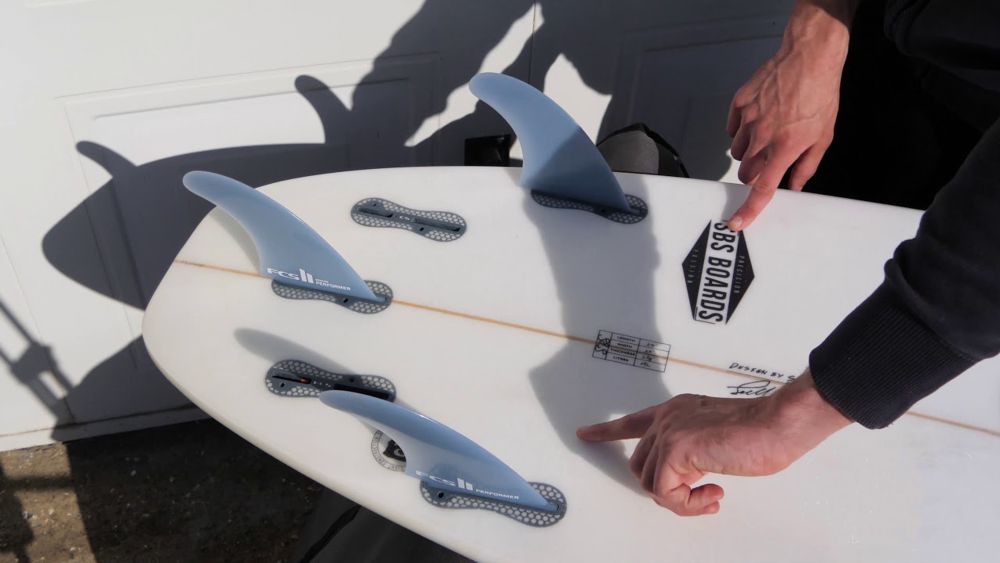
Here are the features of the thruster fin setup:
Ideal Wave Conditions:
- Predictable waves: Thrusters excel in consistent, predictable waves, offering surfers the control and stability needed to perform maneuvers and maintain lines.
- Medium-sized waves: This setup is particularly effective in waves ranging from waist-high to head-high, offering a balance of stability and responsiveness.
- Variety of wave sizes: While optimal performance might differ slightly in very small or large waves, the thruster setup generally adapts well to a broad spectrum of wave sizes, from head-high to overhead.
- Different surfing styles: The balanced nature of the thruster setup caters to various surfing styles, from performing tight, progressive maneuvers to carving smooth lines.
Pros:
- Versatility: The thruster setup caters to a broad range of surfing styles, from beginners learning to turn to experienced surfers seeking performance in various conditions.
- Balance: The three-fin configuration balances stability, control, and maneuverability, allowing surfers to push their limits with confidence.
- Predictability: Thrusters deliver consistent performance, making them ideal for surfers who value control and predictability in their riding.
Cons:
- Less looseness: Unlike fin setups with fewer fins, thrusters can feel slightly less loose and maneuverable, particularly in small, mushy waves.
- Fine-tuning: Finding the perfect fin setup for individual needs might require experimentation, as size, shape, and material can all impact performance.
- Potentially more drag: The presence of three fins can create more drag compared to setups with fewer fins, which may affect top-end speed.
4. 2+1 Fin Setup
A surfboard with fins is a complex system designed to provide water stability, control, and maneuverability. The 2+1 fin setup is a popular option for surfers seeking a balance between the classic feel of a single fin and the increased performance of a thruster (three-fin) setup. This configuration consists of a larger single fin in the center and two smaller side fins on either side, near the board’s tail.
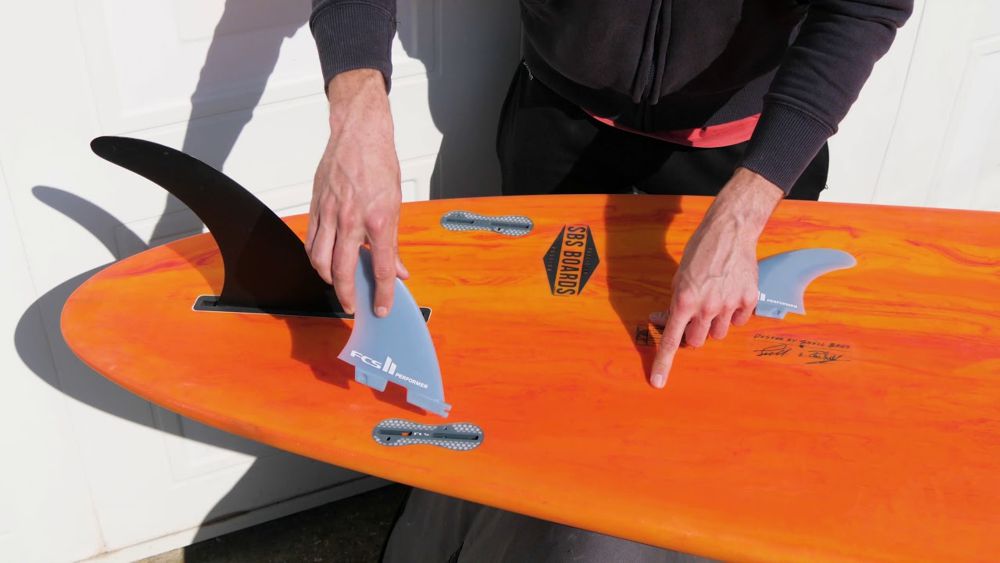
Let’s delve deeper into the ideal wave conditions, advantages, and disadvantages of the 2+1 fin setup:
Ideal Wave Conditions:
- Small to medium waves: The larger center fin provides stability and drive in weaker waves, making the 2+1 suitable for less-powerful conditions.
- Cruising and longboard surfing: The 2+1 setup offers a smooth, flowing ride, ideal for relaxed cruising and longboard styles.
- Cruising and noseriding: The loose feel and added stability can benefit surfers who enjoy relaxed wave riding and noseriding maneuvers.
Pros:
- Looser feel: Compared to thrusters, the 2+1 setup offers a looser, more responsive ride reminiscent of classic single-fin surfboards.
- Increased control: The side fins add control and hold, particularly in critical sections of the wave or during fast maneuvers.
- Versatility: The 2+1 setup can be ridden with or without the side fins, allowing surfers to adjust the board’s performance to match the conditions.
- Generate lift: The specific design of fins can create lift, helping the board plane across the water and maintain speed.
Cons:
- Less drive in larger waves: The single fin may need more drive and hold to power through larger, steeper waves compared to a thruster setup.
- Less maneuverability in tight spaces: While offering control, the side fins can make the board feel slightly less maneuverable in tight pockets of the wave.
- Requires experimentation: Finding the optimal fin placement and size combination for the 2+1 setup can take some trial and error.
- Learning curve: Surfers accustomed to thruster setups may need some time to adjust to the different feel of the 2+1 configuration.
5. Quad Fin Setup
So what is a quad fin setup and its fin placement on surfboard? The quad fin setup, featuring four fins on a surfboard, has become increasingly popular among surfers seeking specific performance characteristics. It offers a unique blend of looseness and control, making it suitable for wider wave conditions than traditional thruster (three fin) setups.

Let’s delve into the ideal wave conditions, pros, and cons of using a quad fin setup:
Ideal Wave Conditions:
- Small, mushy waves: Quads excel in waves lacking power, where the additional fins provide drive and hold.
- Hollow, barreling waves: The increased control from the quad fins allows surfers to grip the steeper sections of the wave and perform powerful maneuvers.
- Windy conditions: Quads offer more stability and control than twin-fin setups, making them a good choice for choppy waves.
Pros:
- Increased drive and hold: Compared to other surfboard fin setups, the four fins provide more surface area in the water, leading to better acceleration and grip, particularly in weaker waves.
- Looser feel: Compared to thrusters, quads offer a looser feel, allowing for quicker turning and smoother rail-to-rail transitions.
- More control in hollow waves: The additional fins offer more control and stability in steeper wave sections, allowing surfers to perform powerful maneuvers.
- Versatility: Quads can be used effectively in various wave conditions, from small and mushy to hollow and barreling.
Cons:
- Less looseness than twin fins: While offering more control than twins, quads are generally less loose and maneuverable, making them less ideal for performing tight turns and radical maneuvers.
- Can feel sluggish in large waves: The additional fins can create drag in larger waves, making the board feel sluggish.
- Requires adjustment: Surfers transitioning from thrusters may need to adjust their surfing style to adapt to the different feel of a quad setup.
6. Boost Fin – Innovation of Surfboard Fin
The traditional surfboard fin, a crucial steering and stability component, has remained unchanged for decades. However, the recent introduction of the electric fin by Boost Surfing presents an innovative twist on this essential equipment. This motorized fin integrates electric propulsion technology into the surfboard, offering a unique experience for surfers of all skill levels. This unique product aims to address some of the challenges surfers and paddlers face, particularly when paddling out to catch waves or travel long distances.

Ideal Wave Conditions:
- Flatwater or small waves: The Boost Fin’s motor assists paddling, allowing surfers to reach desired spots and catch waves they might otherwise miss due to weak conditions.
- Learning to surf: Beginners can utilize the motor to practice technique and maneuvering while conserving energy, making the learning curve less physically demanding.
- Long distances: The motor eases paddling fatigue during extended sessions, enabling surfers to cover greater distances and explore larger areas.
Features:
- Electric motor: Delivers up to 20 lbs of thrust, propelling the board forward at speeds of up to 5 mph.
- Remote control: Enables surfers to adjust speed and activate the motor for on-demand assistance.
- Lithium-ion battery: Provides up to 60-90 minutes of continuous use on a single charge.
- Durable construction: Constructed from glass fiber reinforced polymer and ABS plastic for resilience in saltwater environments.
- Mobile app: Allows users to customize settings, monitor battery life, and access tutorials (available on Android and iOS).
- Universal compatibility: Fits most standard surfboard fin boxes, allowing easy installation.
Benefits:
- Increased paddling power: The Boost Fin provides extra propulsion, making it easier to paddle out to waves or cover longer distances.
- Reduced fatigue: The fin helps conserve energy by assisting with paddling, allowing surfers and paddlers to enjoy longer sessions.
- Enhanced accessibility: Individuals with limited paddling strength can experience the joy of surfing and SUPing with the help of the Boost Fin.
- Convenient: The fin is easily attached to most existing surfboards, SUPs and kayaks, offering a quick and convenient way to add motorized assistance.
While the Boost Fin introduces a novel element to the surfing experience, it’s important to remember that the true essence of surfing lies in the connection with the water and the mastery of its power. Whether you’re a seasoned surfer seeking to push your boundaries or a beginner discovering the joy of riding waves, the Boost Fin offers an innovative tool to enhance your time on the water.
Surf Better with Boost Fin
Understanding surfboard fin setups can help you maximize your surfing experience. This surfboard fins guide has provided a comprehensive overview of the most common fin configurations and their unique characteristics. Remember, the ideal fin setup depends on your surfing style, skill level, and the types of waves you encounter.

For surfers seeking an innovative approach to enhance their surfing, consider the Boost Fin from Boost Surfing. This electric fin system empowers riders with additional propulsion and control, expanding their wave count, reducing fatigue, and fostering enjoyment on the water. Visit the official Boost Surfing online store today to explore the possibilities and unlock a new dimension in your surfing journey.
